Why WPBeginner switched from Mailchimp to Drip – 4 reasons
Apr 20, 2025 am 07:39 AMA few months ago, we replaced our email marketing tool from Mailchimp to Drip. Many of our email newsletter subscribers ask us to write down why we decided to convert.
When it comes to email marketing, it is important to choose the right email marketing service that meets your needs.
In this article, we will share 4 reasons to move from Mailchimp to Drip, and how they can help us send more personalized emails, automated marketing campaigns and more.
Note: This article is part of our WPBeginner Insider series, where we introduce you to the products we use in WPBeginner. We release WPBeginner Insider every other Thursday.

background
In our early days, Mailchimp proved to be the best choice for our email marketing needs. Over the years, we have grown from the largest free WordPress resource company with 3-4 members to a software company operated by over 300 people.
As we grow, we need an email marketing service that is both easy to use and equipped with all the necessary email automation tools to meet our growing needs.
On the other hand, most of our sister brands, such as WPForms, OptinMonster and AIOSEO, are already using Drip, which provides a better email automation tool than Mailchimp.
After careful consideration, we finally decided to move the WPBeginner email list from Mailchimp to Drip.
4 Reasons Why We Got From MailChimp to Drip
Whether you are running a blog, online store, or any business, choosing an email marketing service that suits your needs is the basis for your success.
The top priorities of our email marketing software include customer segmentation and personalization.
That being said, let's first discuss the specific reasons why we switched from Mailchimp to Drip.
1. Better segmentation function
Mailchimp is one of the most popular email marketing tools. But as our email list continues to grow, we realize there are many restrictions that will hinder our growth.
One of them is Mailchimp's limited segmentation capability.
Email segmentation means dividing the subscriber list into smaller target groups so that you can send them the most relevant information.
Generally speaking, it is best to create a list based on demographic and behavioral data, including what the user clicks, the user's selection form for registration, and past purchases.
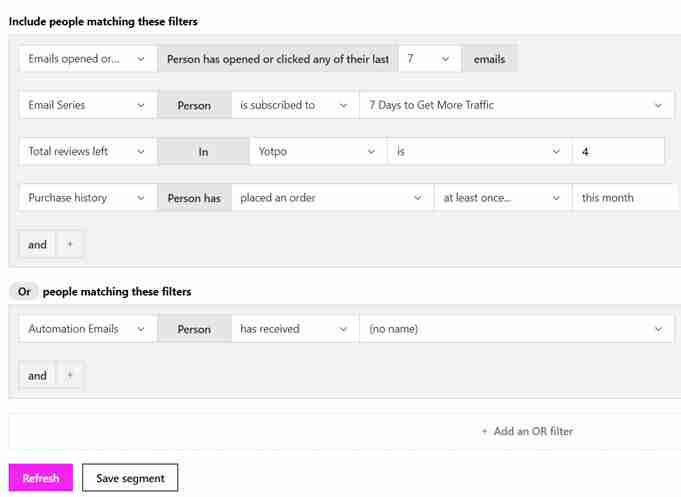
Instead of sending all types of content to everyone, you can send super personalized emails to a specific group of people.
By email segmentation, you can:
- Increase open and click-through rates.
- Achieve higher conversion and return on investment (ROI).
- Increase revenue (in fact, 77% of ROI comes from segmented, targeted and triggered marketing campaigns).
- Receive fewer unsubscribes.
- Improve email delivery rates.
In Mailchimp, you cannot segment the list based on email engagement, such as opening an email and clicking a link to a specific page.
In fact, how users interact with your content is like a vote of trust on what type of content they want to buy from you and the product or service.
Mailchimp does track opens and clicks, but they are only displayed in the report dashboard and cannot be used as an automatic segmentation tool.
At WPBeginner, this means we cannot accurately determine the type of email you like to read, nor can we send more useful content that you think is valuable.
Drip, on the other hand, allows us to segment the email list based on the if-then command. For example, if one of our subscribers clicks on a specific link in the email, we can mark them as someone interested in the topic.
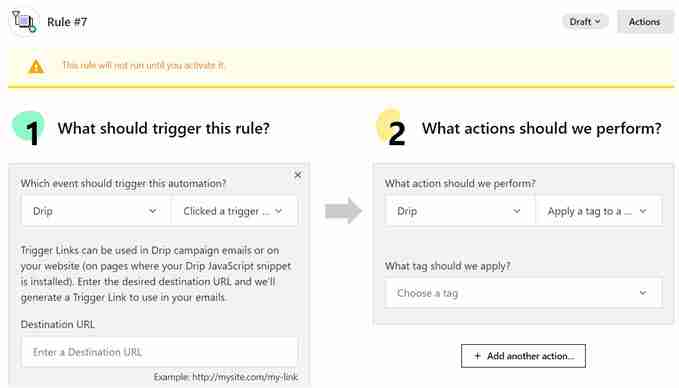
Plus, it allows us to manually segment subscribers when needed. This gives us the flexibility to send the right message to the right people.
This is an important reason why we agree to the Mailchimp alternative.
2. Better personalization
Email personalization is a strategy to customize email content based on the specific behaviors, interests and preferences of an individual recipient.
It is more than simply mentioning their names in the body content or subject line.
If done correctly, it should directly express people’s needs. As a result, they are more likely to open your email, interact with it, or even make a purchase when you sell a product.
We feel that the personalization options provided by Mailchimp are limited.
They do provide merge tags, which means you can dynamically replace content in your email with data you store about your subscribers, but they are limited.
Drip, on the other hand, can do all of this and more with its Liquid tag. For example, you can personalize your email based on your subscriber’s tags, their behavior, the time you automatically send emails, and more.
3. Better email automation features
Email automation means using predefined rules to trigger emails based on specific actions taken or not taken by the subscriber.
As a marketer, your job is to attract audiences from point A to point B. For example, you might focus on building trust with newsletter subscribers to attract them to buy products.
Drip allows you to automate your email policies based on features called workflows. With the workflow, you can intuitively design how to schedule your email marketing campaigns.
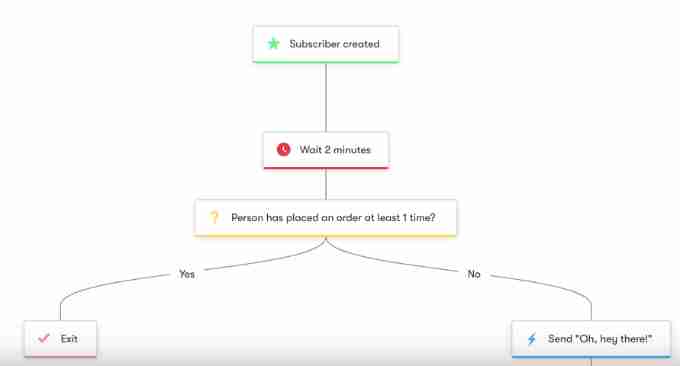
As you can see from the screenshot above, when this workflow is enabled, the person who subscribes to your email list will receive an email 2 minutes after subscribing if he has not placed an order before. With the Drip workflow, if you have an idea, you can build your email marketing campaign the way you want.
We combine workflow with our email series to send customized email campaigns to specific audiences.
4. Simple user interface
Since email marketing platforms can feel overwhelming at the beginning, a simple and straightforward user interface (UI) is very important for user experience.
Mailchimp gives a rather dated, bulky feeling, and tends to be stuffed with options on a page, making it harder to find what you need.
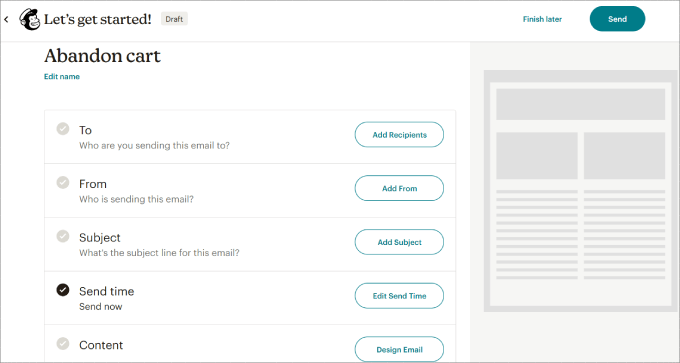
Plus, Drip has a cleaner, more modern user interface that allows you to access all the basic features with just one click.
We believe you don't have to be an email marketing expert to use Drip because everything is templated and can be drag-and-drop.
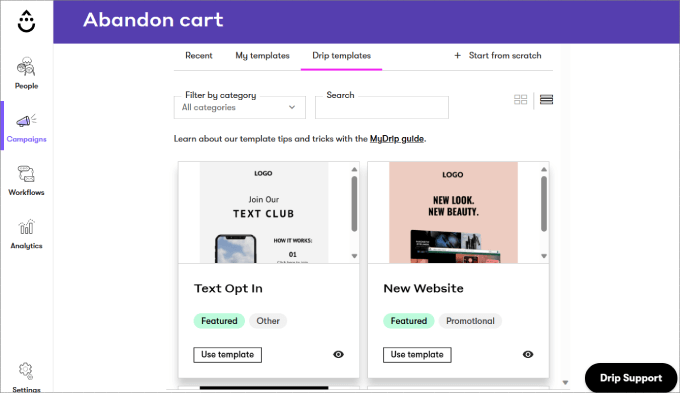
The final thought - a little review
Drip is perfect for our specific email marketing needs, especially since our list has grown significantly over the years. Through their labels, you can create laser target segments. Through the workflow, you can intuitively plan and execute the email marketing campaign you want.
We recommend Drip to businesses that want to expand their email list, especially online stores, because Drip connects to all major e-commerce platforms and allows users to track revenue metrics.
But we know Drip is not for everyone. If your business email list is small or just started using newsletters, it might be too advanced. In this case, you may need to select Continue Contact.
We recommend Constant Contact because they provide all the basic features you need to get started with your email list at an affordable price.
We hope you find this article helpful to understand why we used Drip instead. You might also want to check out our blog for how to create email newsletters the right way, or check out our list of easy ways to quickly expand your email list.
The above is the detailed content of Why WPBeginner switched from Mailchimp to Drip – 4 reasons. For more information, please follow other related articles on the PHP Chinese website!

Hot AI Tools

Undress AI Tool
Undress images for free

Undresser.AI Undress
AI-powered app for creating realistic nude photos

AI Clothes Remover
Online AI tool for removing clothes from photos.

Clothoff.io
AI clothes remover

Video Face Swap
Swap faces in any video effortlessly with our completely free AI face swap tool!

Hot Article

Hot Tools

Notepad++7.3.1
Easy-to-use and free code editor

SublimeText3 Chinese version
Chinese version, very easy to use

Zend Studio 13.0.1
Powerful PHP integrated development environment

Dreamweaver CS6
Visual web development tools

SublimeText3 Mac version
God-level code editing software (SublimeText3)

Hot Topics
 How to avoid risks in the turmoil in the currency circle? The TOP3 stablecoin list is revealed
Jul 08, 2025 pm 07:27 PM
How to avoid risks in the turmoil in the currency circle? The TOP3 stablecoin list is revealed
Jul 08, 2025 pm 07:27 PM
Against the backdrop of violent fluctuations in the cryptocurrency market, investors' demand for asset preservation is becoming increasingly prominent. This article aims to answer how to effectively hedge risks in the turbulent currency circle. It will introduce in detail the concept of stablecoin, a core hedge tool, and provide a list of TOP3 stablecoins by analyzing the current highly recognized options in the market. The article will explain how to select and use these stablecoins according to their own needs, so as to better manage risks in an uncertain market environment.
 Global stablecoin market value PK! Who is the gold substitute in the bear market
Jul 08, 2025 pm 07:24 PM
Global stablecoin market value PK! Who is the gold substitute in the bear market
Jul 08, 2025 pm 07:24 PM
This article will discuss the world's mainstream stablecoins and analyze which stablecoins have the risk aversion attribute of "gold substitute" in the market downward cycle (bear market). We will explain how to judge and choose a relatively stable value storage tool in a bear market by comparing the market value, endorsement mechanism, transparency, and comprehensively combining common views on the Internet, and explain this analysis process.
 The popularity of the currency circle has returned, why do smart people have begun to quietly increase their positions? Look at the trend from the on-chain data and grasp the next round of wealth password!
Jul 09, 2025 pm 08:30 PM
The popularity of the currency circle has returned, why do smart people have begun to quietly increase their positions? Look at the trend from the on-chain data and grasp the next round of wealth password!
Jul 09, 2025 pm 08:30 PM
As the market conditions pick up, more and more smart investors have begun to quietly increase their positions in the currency circle. Many people are wondering what makes them take decisively when most people wait and see? This article will analyze current trends through on-chain data to help readers understand the logic of smart funds, so as to better grasp the next round of potential wealth growth opportunities.
 Virtual Currency Stable Coins Ranking Which is the 'safe haven' in the currency circle
Jul 08, 2025 pm 07:30 PM
Virtual Currency Stable Coins Ranking Which is the 'safe haven' in the currency circle
Jul 08, 2025 pm 07:30 PM
This article will introduce several mainstream stablecoins and explain in depth how to evaluate the security of a stablecoin from multiple dimensions such as transparency and compliance, so as to help you understand which stablecoins are generally considered relatively reliable choices in the market, and learn how to judge their "hazard-haven" attributes on your own.
 Bitcoin breaks new highs, Dogecoin rebounds strongly, will Ethereum keep up with the pace
Jul 09, 2025 pm 08:24 PM
Bitcoin breaks new highs, Dogecoin rebounds strongly, will Ethereum keep up with the pace
Jul 09, 2025 pm 08:24 PM
Recently, Bitcoin hit a new high, Dogecoin ushered in a strong rebound and the market was hot. Next, we will analyze the market drivers and technical aspects to determine whether Ethereum still has opportunities to follow the rise.
 80% of license application loopholes that the platform does not know about. Compliance experts teach you how to use the 'curve approved' strategy
Jul 08, 2025 pm 07:33 PM
80% of license application loopholes that the platform does not know about. Compliance experts teach you how to use the 'curve approved' strategy
Jul 08, 2025 pm 07:33 PM
Under the current severe regulatory environment, the difficulty of directly applying for a specific business license is increasing day by day, and the success rate is not ideal. Many platforms have therefore fallen into development bottlenecks. This article will analyze in detail an efficient "curve approval" strategy, aiming to help you understand how to obtain the required license through indirect compliance. This article will explain its operational process and core points in steps, providing you with a feasible compliance path.
 What are the types of stablecoins? What are the stablecoins in digital currency?
Jul 08, 2025 pm 11:51 PM
What are the types of stablecoins? What are the stablecoins in digital currency?
Jul 08, 2025 pm 11:51 PM
Stable coins maintain price stability by anchoring fiat currencies such as the US dollar, which are mainly divided into three categories: 1. Fiat currency collateralization types such as USDT and USDC; 2. Cryptocurrency collateralization types such as DAI; 3. Algorithm types have higher risks. Mainstream stablecoins include USDT with the highest market value and the best liquidity. USDC is known for its compliance and transparency. DAI relies on the decentralized mechanism. TUSD adopts on-chain real-time audit. BUSD is gradually withdrawing from the market due to supervision. USDP is known for its high compliance and security. Both are widely circulated on mainstream exchanges.
 What are the mainstream public chains of cryptocurrencies? The top ten rankings of cryptocurrency mainstream public chains in 2025
Jul 10, 2025 pm 08:21 PM
What are the mainstream public chains of cryptocurrencies? The top ten rankings of cryptocurrency mainstream public chains in 2025
Jul 10, 2025 pm 08:21 PM
The pattern in the public chain field shows a trend of "one super, many strong ones, and a hundred flowers blooming". Ethereum is still leading with its ecological moat, while Solana, Avalanche and others are challenging performance. Meanwhile, Polkadot, Cosmos, which focuses on interoperability, and Chainlink, which is a critical infrastructure, form a future picture of multiple chains coexisting. For users and developers, choosing which platform is no longer a single choice, but requires a trade-off between performance, cost, security and ecological maturity based on specific needs.






